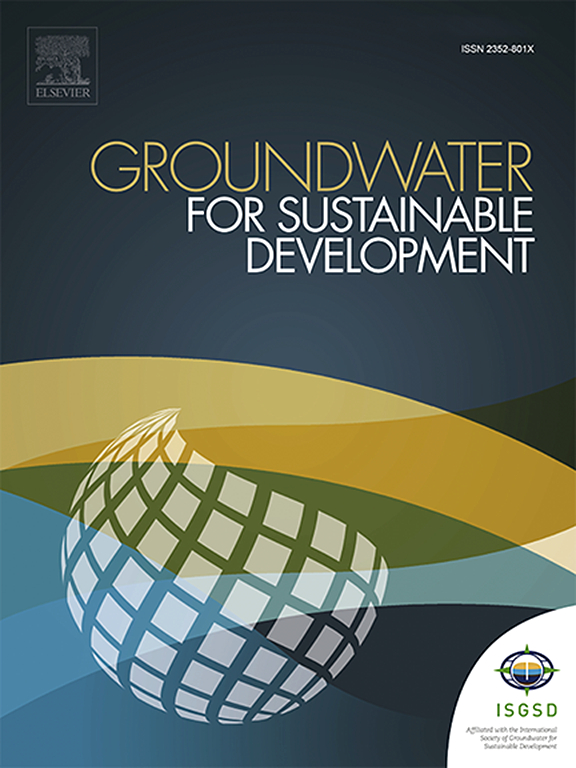Fluoride and nitrate contamination in groundwater of Naini Industrial Area, Uttar Pradesh: Assessing non-carcinogenic human health risk
IF 4.9
Q2 ENGINEERING, ENVIRONMENTAL
引用次数: 0
Abstract
Groundwater is the main source of drinking water globally; however, its quality has been deteriorated due to various geogenic and anthropogenic activities. The groundwater quality of Naini Industrial Area, Prayagraj was studied seasonally to evaluate the fluoride and nitrate contamination pertaining to human health risk assessment. The samples were collected from 60 locations in the pre-monsoon, monsoon, and post-monsoon season. The fluoride and nitrate were assessed with the help of Ion chromatography. The NO3− concentration exceeded the Indian drinking water quality standards in 27% of the groundwater samples. The NO₃⁻ contamination is predominantly associated with agricultural practices, while F⁻ can be linked to natural geological sources. The non-carcinogenic human health risk assessment was quantified by calculating the Hazard Quotient (HQ) and Hazard Index (HI) were calculated as per USEPA methodology for male, female and child population. The findings indicate that the child population is particularly susceptible to health risks associated with the ingestion of F− and NO₃⁻ through the drinking water pathway. Across all the sampled sites, the Hazard Index (HI) values varied from 0.10 to 12.3 for males, 0.09 to 10.6 for females, and 0.16 to 19.7 for children suggesting substantial risk to the local populace at more than half of the locations which is largely related to nitrate contamination. Thus, the study suggests that groundwater at many locations is unsuitable for drinking without treatment pertaining to the probable health risk they pose to consumers advocating upgraded water management plan for the residents.

北方邦奈尼工业区地下水中的氟化物和硝酸盐污染:评估非致癌性人类健康风险
地下水是全球饮用水的主要来源;然而,由于各种地质和人为活动,其质量已经恶化。对普拉亚格拉省奈尼工业区的地下水水质进行了季节性研究,以评价氟化物和硝酸盐污染对人体健康的危害。样本采集于季风前、季风期和季风后的60个地点。用离子色谱法测定了氟和硝酸盐的含量。地下水样本中有27%的NO3−浓度超过印度饮用水质量标准。NO₃⁻与农业活动密切相关,而F⁻与自然地质来源有关。通过计算危害商数(HQ)和危害指数(HI)对男性、女性和儿童人群的非致癌性人类健康风险评估进行量化。研究结果表明,儿童人口特别容易受到与通过饮用水途径摄入F -和NO₃⁻相关的健康风险的影响。在所有采样点,男性的危害指数(HI)值从0.10到12.3不等,女性为0.09到10.6不等,儿童为0.16到19.7不等,这表明在一半以上的地点,当地民众面临重大风险,这主要与硝酸盐污染有关。因此,研究表明,许多地方的地下水不适合饮用,如果不进行处理,可能会给消费者带来健康风险,提倡为居民升级水管理计划。
本文章由计算机程序翻译,如有差异,请以英文原文为准。
求助全文
约1分钟内获得全文
求助全文
来源期刊

Groundwater for Sustainable Development
Social Sciences-Geography, Planning and Development
CiteScore
11.50
自引率
10.20%
发文量
152
期刊介绍:
Groundwater for Sustainable Development is directed to different stakeholders and professionals, including government and non-governmental organizations, international funding agencies, universities, public water institutions, public health and other public/private sector professionals, and other relevant institutions. It is aimed at professionals, academics and students in the fields of disciplines such as: groundwater and its connection to surface hydrology and environment, soil sciences, engineering, ecology, microbiology, atmospheric sciences, analytical chemistry, hydro-engineering, water technology, environmental ethics, economics, public health, policy, as well as social sciences, legal disciplines, or any other area connected with water issues. The objectives of this journal are to facilitate: • The improvement of effective and sustainable management of water resources across the globe. • The improvement of human access to groundwater resources in adequate quantity and good quality. • The meeting of the increasing demand for drinking and irrigation water needed for food security to contribute to a social and economically sound human development. • The creation of a global inter- and multidisciplinary platform and forum to improve our understanding of groundwater resources and to advocate their effective and sustainable management and protection against contamination. • Interdisciplinary information exchange and to stimulate scientific research in the fields of groundwater related sciences and social and health sciences required to achieve the United Nations Millennium Development Goals for sustainable development.
 求助内容:
求助内容: 应助结果提醒方式:
应助结果提醒方式:


